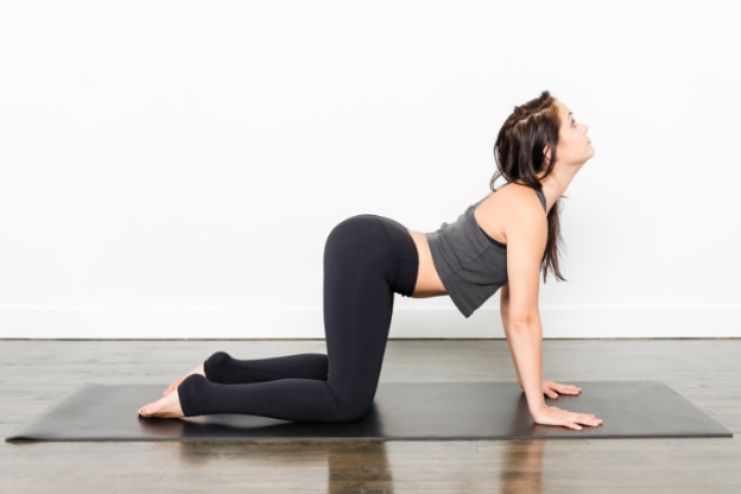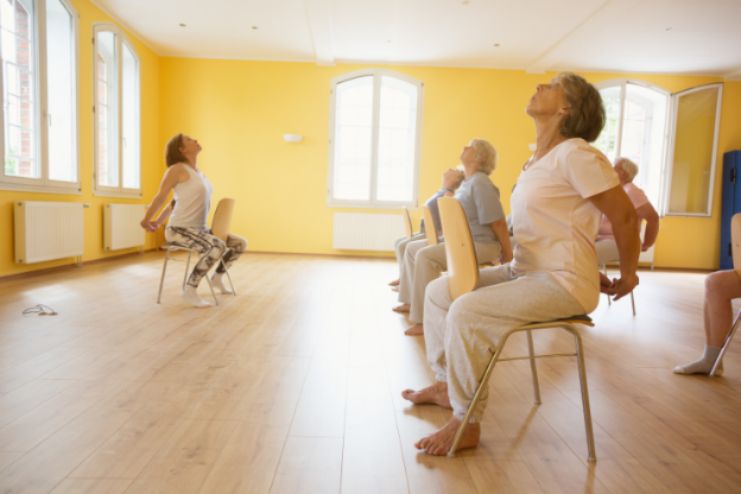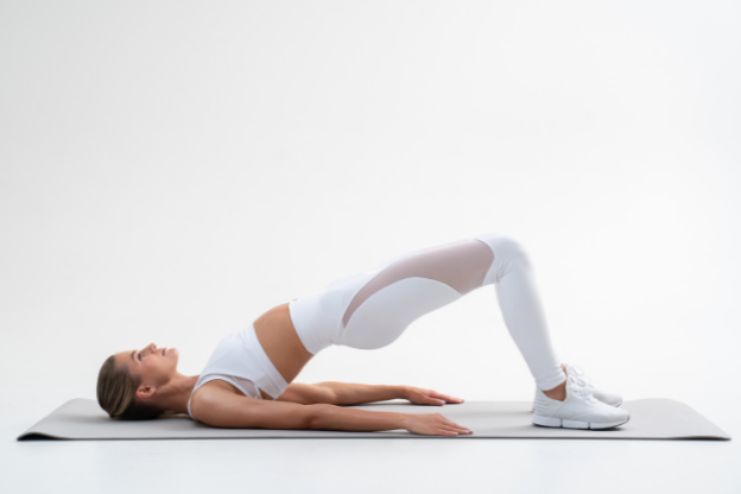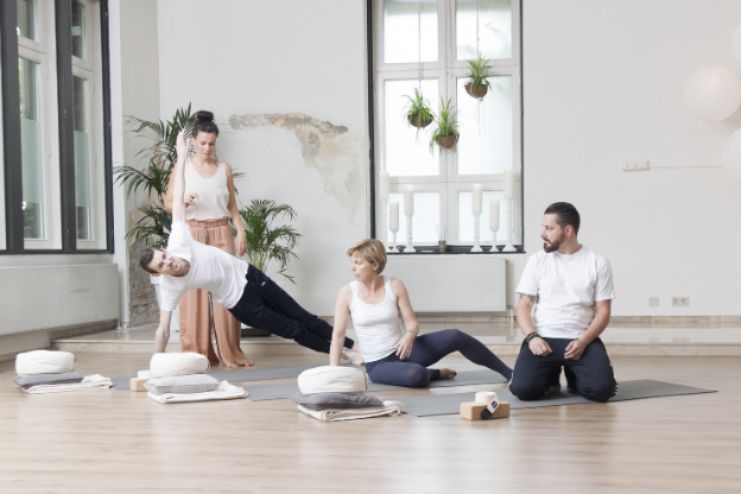Affiliate Disclaimer
Some links in this article are affiliate links. We may earn a small commission if you make a purchase through these links, at no extra cost to you. We only recommend products we find useful to our readersWe all have fast and busy lives that demand physical and mental strength at every point. A stronger body and calm mind can help us win the world. We seek ways to build that perfect mind-body connection but fail often. This is because exercise strengthens your body, and yoga strengthens your mind. But how do we get the best of both worlds? The answer is that to establish a more profound and stronger mind-body connection, we need Somatic Yoga.
Somatic Yoga offers a complete approach by promoting mindful movement and increased body awareness, and it helps release stored tension. It is unique and unlike traditional yoga, which often emphasizes achieving specific postures. Somatic Yoga focuses on gentle, intuitive movements that promote natural alignment and deep relaxation.
Read More: Daily Yoga Poses For Mindfulness and Strength.
The bonus point is that somatic yoga does not need perfection; it focuses on listening to the body’s internal cues. This practice increases awareness, helps relieve chronic pain, improves mobility, and restores balance. By moving with intention and tuning into bodily sensations, Somatic Yoga can help you achieve greater ease and overall well-being. In this article, we will understand the benefits of Somatic Yoga and the ways beginners can start it.
The Philosophy Behind Somatic Yoga
At its core, Somatic Yoga integrates principles from somatics, a field that studies the body’s internal experience in movement. This approach focuses on the mind-body connection and teaches individuals to become more attuned to their internal sensations. You tend to release habitual tension patterns through neuromuscular retraining, leading to improved movement and function.
Benefits of Somatic Yoga
Engaging in Somatic Yoga offers several benefits. Here are a few:
- Improved Flexibility and Mobility: Somatic Yoga involves slow, mindful movements that promote joint mobility and muscular flexibility. This helps reduce stiffness and ease daily activities.
- Relief from Chronic Pain and Tension: We unknowingly hold tension in our bodies, leading to discomfort and pain. Somatic Yoga addresses habitual tension patterns and helps release deep-seated muscular contractions and stiffness.
- Enhanced Mindfulness and Relaxation: Somatic Yoga calms the nervous system. Focusing on internal sensations rather than external postures has a calming effect that reduces stress and anxiety.
- Better Posture and Alignment: Improved awareness about one’s body helps correct posture, promote proper alignment, and reduce strain on joints and muscles.
- Supports Nervous System Regulation: Somatic Yoga involves Gentle, repetitive movements that activate the parasympathetic nervous system. This helps promote relaxation and counteract the stress response.
How Somatic Yoga Differs from Traditional Yoga

Somatic Yoga is distinct and unique. Unlike traditional yoga, where we aim to achieve certain positions and postures, Somatic Yoga focuses on:
- Slow, Intentional Movements: The focus is more on the quality of movement than on the result. This allows for a pain-free experience that gives you freedom to explore.
- Internal Sensations and Awareness: Somatic Yoga encourages practitioners to tune into their body’s subtle messages rather than striving for an external form.
- Accessibility: This approach is perfect for beginners, seniors, and individuals recovering from injuries due to its gentle and easy-to-adapt nature.
Core Principles of Somatic Yoga Practice
Certain core principles of Somatic Yoga help us understand it better. The core elements of Somatic Yoga include:
- Mindfulness and Body Awareness: Developing an improved awareness of movement patterns and releasing habitual tension.
- Gradual, Pain-Free Movements (Pandiculation): This technique involves gentle contractions that help retrain the muscles and nervous system. The calming effect of Somatic Yoga helps relieve pain gradually.
- Breathing Techniques: When you do Somatic Yoga, you indulge in relaxation and mental focus with specific breathing techniques. This helps in deepening the connection between movement and breath.
Read More: Mastering Mindfulness: A Practical Guide For Busy Men.
A Simple Somatic Yoga Routine to Try at Home
Starting your Somatic Yoga journey can be easy with a few basic exercises. Here’s how to get you started:
1. Cat-Cow Stretch:

Cat-Cow is a popular stretch involving a gentle flow between cat and cow poses. It helps warm the body and brings flexibility to the spine. It strengthens abdominal organs by stretching the back, torso, and neck. It also opens the chest and promotes slow and deep breathing. Here’s how you can do this pose:
- You must start on your hands and knees, place your wrists under your shoulders, and keep your knees under your hips.
- Inhale, drop your belly towards the floor, and lift your head and tailbone (Cow Pose).
- Now, exhale, tuck your chin to your chest, and round your spine upwards (Cat Pose).
- Repeat this exercise slowly while syncing movement with breath.
2. Seated Shoulder Rolls:

During the seated shoulder rolls, the muscles relax, and deep breathing helps calm the mind and reduce muscular tension. The stronger muscles provide greater stability, help maintain good posture, and enhance all body movements.
- You must sit straight and comfortably.
- Inhale while lifting your shoulders toward the ears.
- Next, exhale and roll them back and down.
- You can change to the opposite direction after a few repetitions.
3. Pelvic Tilts:

Pelvic tilt exercises help activate the intrinsic core stabilizers, which means that the core is working. This prevents excessive strain on the lower back. These moves also help correct posture and give strength and flexibility.
- First, lie on your back with your knees bent and feet flat on the ground.
- Inhale and tilt your pelvis forward while slightly arching your lower back.
- Next, exhale and tilt your pelvis backward while pressing your lower back into the mat.
- Move smoothly with your breath, avoiding strain.
Who Can Benefit from Somatic Yoga?
Anybody can do Somatic Yoga. However, Somatic Yoga is particularly beneficial for:
- Seniors: Somatic Yoga helps promote balance and mobility in seniors and adults who tend to experience loss of balance and stability while doing their daily chores.
Read More: Finding Balance: Yoga and Meditation For Senior’s Physical and Mental Health
- Individuals with Chronic Pain: Somatic Yoga provides practical pain management and tension release techniques with easy movements and breathing techniques.
- Athletes & Active Individuals: Somatic Yoga improves mobility, recovery, and injury prevention through neuromuscular awareness.
- Those Seeking Stress Relief: Somatic Yoga helps people with chronic stress by promoting deep relaxation and improved sleep quality.
How to Get Started with Somatic Yoga

If you are a beginner and wish to start Somatic Yoga, you can:
- Find Online Videos or Certified Instructors: Numerous resources are available to guide you through the practice, or you can seek accurate guidance from certified professionals.
- Start with Short Sessions: Gradually start with small sessions of 10-15 minutes, and increase it as you adapt.
- Use Props for Comfort: You can use yoga mats, cushions, or blankets to support your practice.
Read More: 11 Best Yoga Bolster Experience Comfort
Conclusion:
Somatic Yoga is beyond a movement practice. It is an approach that helps restore balance, reduce pain, deal with chronic stress, and release muscle tension while deepening self-awareness. You can integrate mindful movement with conscious breathing techniques and promote both physical and mental well-being. With Somatic Yoga, you can build a deep bond between your mind and body.
Try this amazing yoga mat, which folds and can be carried anywhere easily. It is loved by thousands, and you can buy it here!
Including a few minutes of Somatic Yoga into your daily routine will significantly improve your flexibility, reduce stress, and relax your body overall. Regular practice can help you retrain your nervous system, improve ease and flexibility, and release habitual tension and stress.
Here’s your chance to give Somatic Yoga a chance.
Are you ready to begin a relaxing journey of mindful movement?
References
- https://www.takingcharge.csh.umn.edu/what-is-the-mind-body-connection
- https://www.anytimefitness.com/ccc/care/what-are-somatic-exercises-a-guide-for-beginners/
- https://www.yogarenewteachertraining.com/what-is-a-somatic-workout/
- https://www.ekhartyoga.com/resources/styles/yoga-and-somatics
- https://dihickman.com/cat-cow-for-lower-back-pain/
- https://www.yogawithrachelmarie.com/post/somatic-yoga-exercises-for-beginners
[/vc_column_text]
In this Article


















